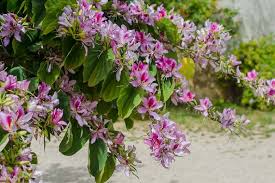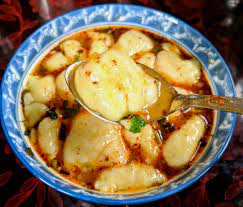Share this Article
Koiralo ko Phool – The Bauhinia Blossom of Nepal
Introduction
Nepal, embraced by the majestic Himalayas, is renowned for its breathtaking natural scenery and rich plant life. Among its many botanical treasures, the Koiralo ko Phool (Bauhinia variegata) stands out as an extraordinary flower admired for its vivid appearance, versatile uses, and cultural importance. This flower isn't just admired for its seasonal bloom—it plays a meaningful role in the daily lives of many Nepali people.
Koiralo trees thrive throughout Nepal, particularly in the hill regions and subtropical zones. These trees begin to bloom from late winter through early spring, transforming the hills and countryside with beautiful shades of pink, purple, and white. For the Nepali people, this flower is not only visually appealing—it serves as food, traditional medicine, a symbol in cultural practices, and even a means of livelihood. This article aims to provide an in-depth, positive exploration of the Koiralo flower and its significance.
Botanical Description
Koiralo is a medium-sized deciduous tree that loses its leaves once every year. It commonly grows in Nepal’s mid-hill areas, along forest boundaries, and is also found in many home gardens.
· Leaves
. The leaves are uniquely shaped with two distinct lobes, resembling the footprint of a camel. Due to this distinctive shape, the tree is often referred to as the "camel’s foot tree." These leaves are large, soft to the touch, and have a light green color that changes to yellow before they fall off in winter.
· Flowers
. The flowers of the Koiralo tree have five petals and come in various shades, ranging from pale pink to deep purple, and sometimes white. They bloom mainly between February and April, which corresponds to the Nepali months of Falgun to Chaitra. These blossoms emit a pleasant fragrance and attract pollinators such as bees and butterflies.
· Fruits and Seeds
. Once flowering ends, the tree produces long, flat seed pods that contain round, brown seeds inside. These pods dry out during the summer months and eventually split open to release the seeds.
Culinary Value – A Traditional Delight
- Koiralo ko Achar (Pickle)
This is the most popular dish made from Koiralo flowers. The buds are first steamed to reduce their natural bitterness, then mixed with ingredients like mustard seeds, turmeric, salt, chili, lemon juice, and sometimes timur (Szechuan pepper). The pickle offers a tangy, mildly bitter, and flavorful taste and is typically served alongside dal bhat or special meals. - Fried Koiralo
Flowers are sautéed with onions, garlic, green chilies, turmeric, and spices to create a tasty, nutritious side dish enjoyed in many households. - Mixed Vegetable Curry
Occasionally, Koiralo flowers are cooked with vegetables such as potatoes, tomatoes, or lentils in a curry. The bitterness of the flowers adds a balanced contrast to the sweetness of the other ingredients, resulting in a rich and complex flavor.
Medicinal and Ayurvedic Properties
- Digestive Support
The slightly bitter flowers act as a digestive aid, stimulating appetite and helping to cleanse the digestive tract. - Anti-inflammatory Effects
Extracts from the bark and flowers are used to reduce inflammation, ease body aches, and relieve joint pain. They are commonly applied in herbal remedies for arthritis and muscle soreness. - Respiratory Benefits
Herbal decoctions made from the bark or dried flowers help alleviate symptoms of cough, asthma, and chest congestion. - Wound Healing
A paste made from crushed leaves or bark is applied to minor wounds or skin infections. Its natural antiseptic qualities help speed up healing.
Environmental and Ecological Value
- Attracting Pollinators
The vibrant flowers of the Koiralo tree draw in bees, butterflies, and other pollinators, which are essential for plant reproduction and sustaining a healthy ecosystem. - Preventing Soil Erosion
The strong root system of Koiralo stabilizes the soil, particularly on slopes, helping to reduce erosion and the risk of landslides. - Carbon Sequestration
Like other trees, Koiralo absorbs carbon dioxide and releases oxygen, contributing to cleaner air and helping to fight climate change. - Providing Shade and Shelter
Its wide canopy offers shade for people, animals, and crops. In rural areas, it also serves as a resting place for farmers and travelers.
Koiralo Farming and Economic Opportunities
- Flower Cultivation
Farmers can grow Koiralo in community forests or agroforestry setups to harvest flowers, seed pods, and bark for various uses. - Value-added Products
Items such as dried Koiralo flower tea, pickles, herbal powders, and essential oils can be produced and sold under organic or traditional product labels. - Job Creation
Training women’s groups, youth organizations, and cooperatives in processing and marketing Koiralo products can create employment and empower local communities.
Conservation and Sustainable Practices
- Raising Community Awareness
Teaching people about the significance of Koiralo in terms of nutrition, health benefits, and environmental value can encourage them to protect the tree and reduce deforestation. - Reforestation Efforts
Koiralo should be included in tree-planting initiatives at schools, parks, public areas, and damaged lands to help restore green cover and promote biodiversity. - Research and Exploration
Further scientific studies are necessary to discover new applications, improve cultivation methods, and better understand the medicinal qualities of Koiralo.
Conclusion
Koiralo ko Phool is more than just a seasonal flower. It’s a symbol of Nepal’s beauty, resilience, wisdom, and culture. Whether growing in forests, blooming in gardens, served on plates, or used in home remedies, this flower represents the deep-rooted harmony between people and nature. In a time when modern life is speeding up, the presence of Koiralo reminds us to slow down and appreciate the gifts of the earth. Promoting, protecting, and celebrating this native flower will help preserve Nepal’s natural and cultural heritage for generations to come.
Categories:
Culture & Traditions
Tags:
BauhiniaVariegata







